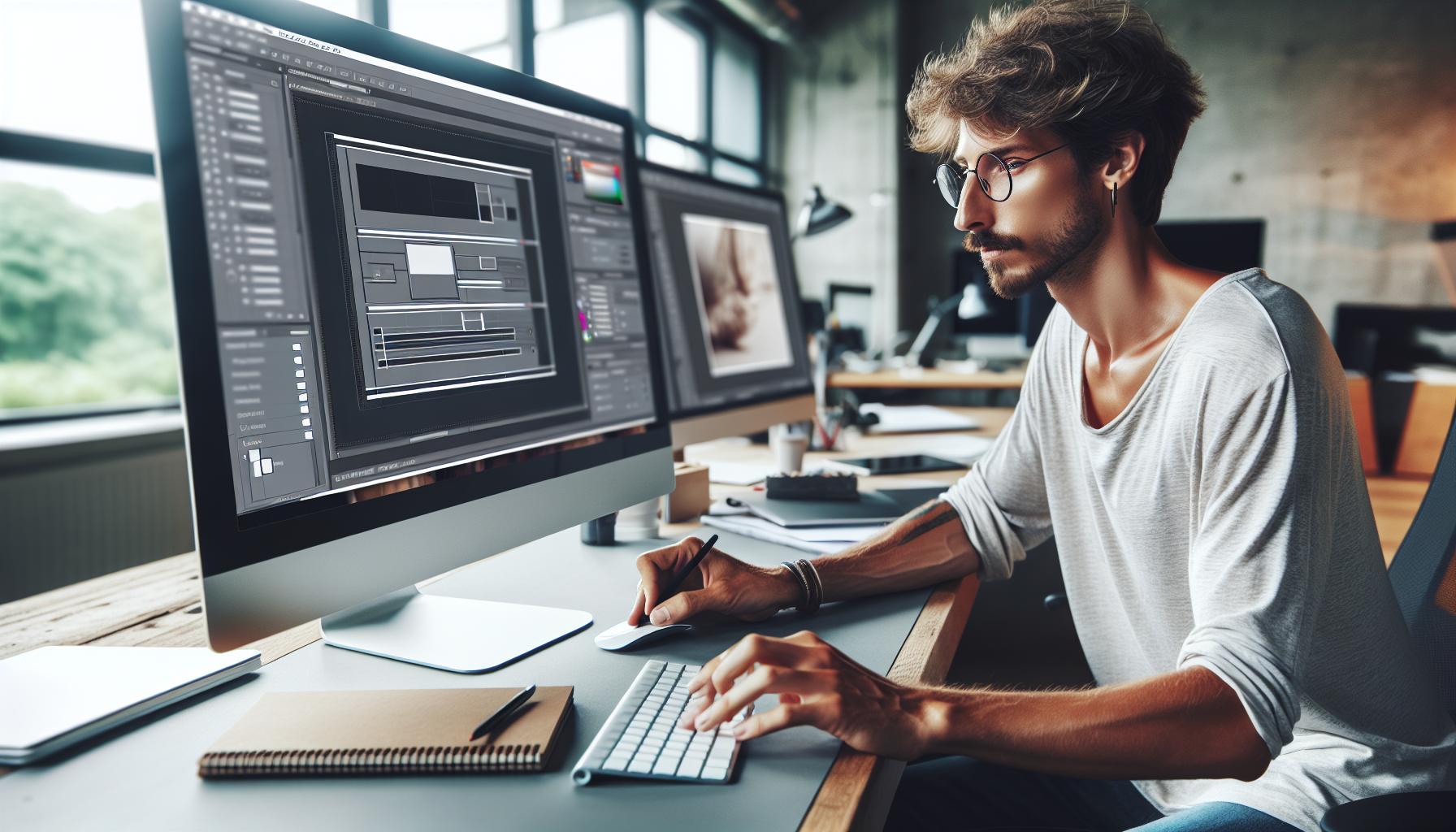
Why Image Optimization for Web Speed Matters in Ecommerce
In the fast-paced world of online shopping, customers expect instant results. Imagine a potential customer clicking on a stylish dress on your ecommerce site. They are excited to see more, envisioning themselves wearing it. But instead of a crisp, clear image loading instantly, they are met with a spinning wheel, a blank space, or a blurry picture slowly materializing. In today’s impatient digital age, this delay can be the difference between a sale and a lost opportunity. Slow loading times frustrate users, leading them to abandon their carts and seek faster, more responsive online stores. For ecommerce businesses, particularly in visually-driven sectors like fashion, optimizing website speed is not just a technical tweak; it’s a critical element of the customer experience and overall business success. This optimization journey begins with your images.
Images are the heart and soul of online fashion retail. They showcase your products, tell a story, and create desire. High-quality, visually appealing photos are essential to attracting customers and driving conversions. However, these high-resolution images, if not properly optimized, can become a major drag on your website’s loading speed. This blog post will explore why image optimization is paramount for web speed in ecommerce, especially for fashion businesses, and provide actionable strategies to ensure your stunning visuals contribute to, rather than detract from, a seamless and speedy online shopping experience. We will delve into the techniques, tools, and best practices that empower ecommerce store owners to strike the perfect balance between visual appeal and website performance, ensuring they not only capture attention but also keep customers engaged and converting.
Key Takeaways:
- Website speed is crucial for ecommerce success: Slow websites lead to higher bounce rates, lower conversion rates, and decreased customer satisfaction.
- Images are often the biggest culprit for slow loading times: Unoptimized images significantly impact page load speed, especially in image-heavy ecommerce sites.
- Image optimization is about balancing quality and file size: It’s possible to reduce image file sizes without significantly compromising visual quality.
- Various techniques can be used for image optimization: These include choosing the right file format, compression, resizing, and using modern techniques like lazy loading and CDNs.
- Optimized images improve user experience and SEO: Faster websites rank higher in search results and provide a better experience for customers, leading to increased sales.
- Ecommerce fashion businesses must prioritize image optimization: Given the visual nature of fashion, optimized images are non-negotiable for providing a superior online shopping experience and maintaining a competitive edge.

The Need for Speed: Why Website Load Time is a Deal Breaker in Ecommerce
In the digital marketplace, speed is king. Numerous studies and industry data consistently demonstrate the direct link between website loading speed and key ecommerce metrics. Think about your own online shopping behavior. How long are you willing to wait for a webpage to load before clicking away? Likely, not very long. Research indicates that a significant percentage of online shoppers abandon websites that take longer than just a few seconds to load. For ecommerce businesses, this translates directly into lost revenue and missed opportunities.
Slow website speeds negatively impact several critical aspects of an ecommerce business:
- Bounce Rate: A high bounce rate, the percentage of visitors who leave your site after viewing only one page, is a major red flag. Slow loading times are a primary driver of high bounce rates. Customers who are kept waiting will simply leave and find a competitor with a faster, more responsive website.
- Conversion Rate: Every second delay in page load time can lead to a significant drop in conversion rates. Customers who experience frustration due to slow loading times are less likely to complete a purchase. A seamless, speedy shopping experience is essential for guiding customers through the sales funnel and encouraging them to convert.
- User Experience (UX): Website speed is a fundamental element of user experience. A slow website creates a negative first impression, making your online store feel unprofessional and unreliable. Conversely, a fast, responsive website contributes to a positive user experience, fostering trust and encouraging repeat visits.
- Search Engine Optimization (SEO): Google and other search engines prioritize website speed as a ranking factor. Faster websites are rewarded with higher search rankings, leading to increased organic traffic. In today’s competitive online landscape, optimizing for search engines is crucial for visibility and attracting new customers, and website speed plays a vital role in this.
- Mobile Experience: With the majority of online shopping now happening on mobile devices, website speed is even more critical. Mobile users are often on slower connections and have even less patience for slow loading times. A slow mobile site can be particularly detrimental to your ecommerce business.
Consider the data. For instance, a study by Google found that 53% of mobile site visitors will leave a page that takes longer than three seconds to load. Another study by Akamai revealed that a 100-millisecond delay in website load time can hurt conversion rates by 7%. These statistics underscore the undeniable importance of website speed in today’s ecommerce landscape. For fashion ecommerce, where visual appeal and quick browsing are paramount, speed is not just a technical consideration, it’s a core element of the shopping experience.
Images: The Beauty and the Burden of Ecommerce Websites
Images are indispensable for ecommerce, especially in the fashion industry. Customers cannot physically touch or try on clothing online, so high-quality product images are their primary source of information and inspiration. Ecommerce sites are inherently visual, relying heavily on images to showcase products, convey brand aesthetics, and create an engaging shopping experience. However, the very images that make your website attractive can also be the primary culprits behind slow loading times.
High-resolution images, while visually stunning, often come with large file sizes. These large files take longer to download and display on a user’s browser, leading to slow page load times. When a webpage is loaded, the browser has to download all the resources, including text, code, and images. Images typically constitute a significant portion of the total page weight. For image-rich ecommerce sites, particularly fashion sites with numerous product photos, lookbooks, and lifestyle images, unoptimized images can severely bloat page size and dramatically slow down loading times.
The challenge for ecommerce store owners, especially in fashion, is to strike a delicate balance. They need to use high-quality, visually appealing images to attract and engage customers, but they also need to ensure these images are optimized for web speed to avoid frustrating users and losing sales. This is where image optimization techniques become essential. It’s about finding the sweet spot where image quality remains excellent while file sizes are significantly reduced, resulting in faster loading times and a superior user experience.

Image Optimization Techniques: Strategies for Speed and Visual Appeal
Fortunately, optimizing images for web speed doesn’t mean sacrificing visual quality. A range of effective techniques allows you to significantly reduce image file sizes without noticeably compromising their appearance to the average online shopper. Here are some key strategies to implement:
-
- Choose the Right File Format: Selecting the appropriate image file format is the first crucial step in optimization. Different formats are suited for different types of images and offer varying levels of compression and quality.
- JPEG (or JPG): JPEG is the most widely used format for photographs and complex images on the web. It uses lossy compression, which means some image data is discarded to reduce file size. However, with careful optimization, the loss in quality can be minimal and often imperceptible to the human eye, especially for web display. JPEGs are excellent for product photos, lifestyle images, and most photographic content in fashion ecommerce.
- PNG: PNG is a lossless format, meaning it preserves all image data during compression, resulting in higher quality images compared to JPEGs at similar file sizes. PNGs are ideal for images with sharp lines, text, logos, and graphics with transparency. However, PNG files are generally larger than JPEGs for photographs. For ecommerce, use PNGs for logos, icons, and detailed graphics, but prioritize JPEGs for product photos when file size is a concern.
- WebP: WebP is a modern image format developed by Google that offers superior compression and quality compared to both JPEG and PNG. WebP images can be significantly smaller than JPEGs and PNGs while maintaining comparable or even better visual quality. WebP supports both lossy and lossless compression, as well as transparency and animation. While browser support for WebP is now very strong, it’s still wise to provide fallback JPEGs or PNGs for older browsers. Adopting WebP can be a highly effective way to significantly reduce image file sizes across your ecommerce site.
- GIF: GIFs are primarily used for animated images. They are a lossless format but are best suited for simple animations with limited colors. For most ecommerce product images, GIFs are not the ideal choice unless you are showcasing a simple animated detail of a product.
- Choose the Right File Format: Selecting the appropriate image file format is the first crucial step in optimization. Different formats are suited for different types of images and offer varying levels of compression and quality.
-
- Compression: Striking the Right Balance: Image compression is the process of reducing the file size of an image. There are two main types of compression:
- Lossy Compression: Lossy compression, used by formats like JPEG and WebP, permanently removes some data from the image to reduce file size. The key is to apply lossy compression judiciously, aiming for the highest level of compression that doesn’t noticeably degrade image quality. For ecommerce product photos, a slight reduction in quality for a significant reduction in file size is often a worthwhile trade-off.
- Lossless Compression: Lossless compression, used by formats like PNG and also available in WebP, reduces file size without discarding any image data. Lossless compression typically results in larger files compared to lossy compression, but it is essential for images where quality preservation is paramount, such as logos and graphics where sharp lines and details must be maintained.
Numerous online tools and software are available to compress images. For ecommerce workflows, consider using batch image compression tools to efficiently optimize large volumes of product photos.
- Compression: Striking the Right Balance: Image compression is the process of reducing the file size of an image. There are two main types of compression:
-
- Resize and Scale Images Appropriately: One of the most common mistakes is using images that are much larger than necessary for their display size on the webpage. For example, if your product thumbnail image is displayed at 200×200 pixels, using a 1000×1000 pixel image and simply resizing it in the browser is highly inefficient. The browser still has to download the large 1000×1000 pixel file, even though it only displays a smaller version.
- Resize Images Before Uploading: Always resize images to the exact dimensions they will be displayed on your website before uploading them. Use image editing software or online resizing tools to create appropriately sized versions of your images. For example, create separate image sizes for product thumbnails, product detail pages, and zoom views.
- Responsive Images: Implement responsive images using HTML’s
<picture>element orsrcsetattribute in the<img>tag. This allows the browser to automatically select the most appropriately sized image based on the user’s device screen size and resolution, further optimizing image delivery and speed across different devices.
- Resize and Scale Images Appropriately: One of the most common mistakes is using images that are much larger than necessary for their display size on the webpage. For example, if your product thumbnail image is displayed at 200×200 pixels, using a 1000×1000 pixel image and simply resizing it in the browser is highly inefficient. The browser still has to download the large 1000×1000 pixel file, even though it only displays a smaller version.
-
- Lazy Loading: Loading Images on Demand: Lazy loading is a technique that defers the loading of images that are below the fold (not immediately visible in the browser window when the page initially loads). Images are only loaded as the user scrolls down the page and they come into view.
- Improve Initial Page Load Time: Lazy loading significantly reduces the initial page load time, as the browser only needs to download the images that are immediately visible. This is particularly beneficial for image-heavy ecommerce pages, like category pages or product listings.
- Enhance User Experience: Users perceive the website as loading much faster, even if all images eventually load. Lazy loading creates a smoother and more responsive browsing experience, especially on mobile devices.
- Implement Lazy Loading Easily: Lazy loading can be implemented using HTML attributes (
loading="lazy"), JavaScript libraries, or ecommerce platform plugins.
- Lazy Loading: Loading Images on Demand: Lazy loading is a technique that defers the loading of images that are below the fold (not immediately visible in the browser window when the page initially loads). Images are only loaded as the user scrolls down the page and they come into view.
- Content Delivery Networks (CDNs): Distributing Images Globally: A CDN is a network of servers distributed geographically. When you use a CDN, your website’s static assets, including images, are stored on these servers. When a user requests your website, the CDN serves the images from the server closest to their location.
- Faster Image Delivery: CDNs significantly reduce latency and improve image delivery speed, especially for users who are geographically distant from your website’s main server.
- Improved Website Performance Globally: CDNs ensure consistent website performance for users worldwide, which is crucial for ecommerce businesses with international customers.
- Scalability and Reliability: CDNs also improve website scalability and reliability by distributing traffic across multiple servers. Many hosting providers and ecommerce platforms offer CDN integration or built-in CDN services.
Case Study: “StyleForward Boutique” Boosts Conversions with Image Optimization
StyleForward Boutique, a mid-sized online fashion retailer specializing in contemporary women’s wear, was experiencing a concerningly high bounce rate and lower-than-expected conversion rates. Website analytics revealed that their category pages and product detail pages were loading slowly, particularly on mobile devices. A website speed audit identified large, unoptimized product images as a major contributor to the slow loading times.
“Our product photography was stunning,” explains Alex Morgan, the Ecommerce Manager at StyleForward Boutique. “We invested heavily in high-quality images to really showcase the details and textures of our clothing. However, we hadn’t considered the impact of these large image files on our website’s performance.”
StyleForward Boutique partnered with a web performance consultant to implement a comprehensive image optimization strategy. They undertook the following steps:
- Image Format Conversion: Converted all product images to WebP format, providing fallback JPEGs for older browsers.
- Lossy Compression: Applied optimized lossy compression to all JPEG and WebP images, carefully balancing file size reduction with visual quality.
- Image Resizing: Resized all product images to appropriate display dimensions for thumbnails, category pages, and product detail pages. Implemented responsive images for different screen sizes.
- Lazy Loading Implementation: Implemented lazy loading for all product images on category and product detail pages.
- CDN Integration: Integrated a CDN to serve images from geographically closer servers to their global customer base.
Results:
Within weeks of implementing these image optimization measures, StyleForward Boutique saw remarkable improvements:
- Page Load Time Reduction: Average page load time decreased by 45% across all devices. Mobile page load time improved even more significantly.
- Bounce Rate Decrease: Bounce rate decreased by 22%, indicating that visitors were staying on the site longer.
- Conversion Rate Increase: Conversion rate increased by 15%, demonstrating a direct positive impact on sales.
- Improved User Experience: Customer feedback surveys showed a significant improvement in perceived website speed and overall user experience.
“The impact of image optimization was immediate and dramatic,” says Alex. “Our website feels so much faster now, and our customers are clearly noticing the difference. The increase in conversions and the decrease in bounce rate have been truly game-changing for our business. It’s proof that website speed and image optimization are not just technical details, they are critical drivers of ecommerce success.”
Expert Opinion 1:

“In today’s mobile-first world, website speed is no longer a ‘nice-to-have’ but a ‘must-have’ for ecommerce businesses,” states Jordan Smith, a renowned web performance expert and consultant. “Images are often the largest assets on ecommerce pages, and unoptimized images are a major bottleneck. Ecommerce store owners need to prioritize image optimization as a core part of their web performance strategy. By implementing techniques like proper file formats, compression, resizing, lazy loading, and CDNs, they can significantly improve website speed, enhance user experience, and boost their bottom line. For fashion ecommerce, where visual presentation is paramount, striking the right balance between image quality and file size is absolutely essential for online success.”
Tools and Resources for Image Optimization
Numerous tools and resources are available to help ecommerce store owners streamline their image optimization workflows:
- Online Image Compression Tools: TinyPNG, ImageOptim, Compressor.io, and Squoosh.dev are popular online tools for compressing JPEG, PNG, and WebP images. These tools often offer both lossy and lossless compression options and allow you to easily optimize images in bulk.
- Image Editing Software: Adobe Photoshop, Affinity Photo, and GIMP offer robust image editing capabilities, including resizing, format conversion, and compression options. These tools provide more control over the optimization process and are suitable for professional image editing workflows.
- Ecommerce Platform Plugins and Apps: Shopify, WooCommerce, Magento, and other ecommerce platforms offer plugins and apps specifically designed for image optimization. These tools often automate optimization processes, such as automatic compression, resizing, and lazy loading, making it easier to optimize images within your ecommerce platform environment. Examples include: Shopify’s “Image Optimizer” apps, WooCommerce plugins like “Smush” or “Optimole”.
- Website Speed Testing Tools: Google PageSpeed Insights, GTmetrix, and WebPageTest are valuable tools for analyzing your website’s speed and identifying image optimization opportunities. These tools provide detailed reports on page load time, page size, and performance metrics, highlighting areas for improvement, including unoptimized images.
Balancing Quality and Speed: Finding the Sweet Spot
A common concern among ecommerce store owners is that image optimization might compromise image quality. While aggressive compression can indeed degrade image quality, effective image optimization is about finding the right balance. The goal is not to achieve the smallest possible file size at all costs, but rather to reduce file size significantly while maintaining visually excellent image quality that satisfies online shoppers.
- Focus on Perceived Quality: Optimize images for web display, not for print or high-resolution viewing. On typical computer and mobile screens, minor reductions in image quality due to compression are often imperceptible to the average user.
- Test and Iterate: Experiment with different compression levels and settings to find the sweet spot where file size is significantly reduced without noticeable quality degradation. Use website speed testing tools to measure the impact of your optimization efforts on page load time.
- Prioritize Key Images: For crucial product images that directly influence purchase decisions, prioritize slightly higher quality and less aggressive compression. For less critical images, or thumbnails, you might opt for more aggressive compression to maximize speed.
- Regularly Review and Optimize: Image optimization is not a one-time task. As you add new products and update your website, make image optimization a standard part of your workflow. Regularly review your website’s speed and image performance and make adjustments as needed.
Best Practices for Ecommerce Image Optimization in Fashion
For fashion ecommerce businesses, given the critical role of visual merchandising and high-quality imagery, image optimization is particularly important. Here are some best practices tailored for fashion ecommerce:
- High-Quality Photography is Still Essential: Optimization should enhance, not compensate for, poor photography. Start with high-quality, well-lit, and professionally photographed product images. Optimization refines these excellent images for web performance.
- Showcase Details and Textures: Fashion products often rely on details like fabric texture, stitching, and embellishments. Ensure your optimized images still clearly showcase these details to help customers appreciate the product quality. Use zoom features on product detail pages to allow customers to examine details closely, and optimize zoom images appropriately as well.
- Maintain Brand Consistency: Ensure that image optimization settings and quality levels are consistent across all product images to maintain a cohesive and professional brand aesthetic.
- Optimize Lifestyle and Editorial Images: Don’t just focus on product images. Optimize lifestyle images, lookbook photos, and other editorial content that contributes to your brand storytelling and visual appeal.
- Mobile-First Optimization: Prioritize mobile image optimization. Test your website speed and image performance specifically on mobile devices, as mobile users are often more sensitive to slow loading times.
- Regular Audits and Monitoring: Conduct regular website speed audits and monitor image performance using website analytics and speed testing tools. Stay updated with the latest image optimization techniques and best practices.
Pixel By Hand: Your Partner in Image Excellence and Efficiency
For ecommerce fashion businesses seeking to streamline their image post-production workflow and ensure both outstanding visual quality and optimal web speed, Pixel By Hand offers specialized services designed to address these critical needs. Understanding the unique demands of the fashion ecommerce industry, Pixel By Hand provides tailored image editing and optimization solutions that align with the goals of ecommerce operations managers like Sarah.
Pixel By Hand’s expertise in fashion product image post-production directly contributes to image optimization for web speed in several key ways:
- Efficient Image Editing Workflows: Pixel By Hand’s personalized approach and proprietary platform streamline image editing workflows, ensuring fast turnaround times and efficient processing of large volumes of images. This efficiency directly translates to faster product launches and quicker website updates, minimizing delays that can impact website speed and customer experience.
- Quality-Focused Optimization: Pixel By Hand’s team of experienced retouchers understands the importance of maintaining high visual quality for fashion product images. They skillfully apply optimization techniques, including format conversion, compression, and resizing, to reduce file sizes without compromising the visual appeal and detail necessary to showcase fashion products effectively. This balance of quality and speed is at the core of Pixel By Hand’s service.
- Customized Solutions: Recognizing that each ecommerce business has unique needs and brand guidelines, Pixel By Hand offers customized solutions tailored to specific requirements. They work closely with clients to understand their image quality standards, website speed goals, and brand aesthetics, ensuring that the optimized images align perfectly with their overall ecommerce strategy.
- Expertise in Fashion Ecommerce Imagery: Pixel By Hand’s specialization in fashion ecommerce means they possess deep understanding of the visual nuances and requirements of this industry. They are adept at retouching and optimizing fashion images to highlight garment details, fabric textures, and model presentation while ensuring optimal web performance.
- Technology and Automation: Pixel By Hand leverages the latest technologies and automation tools to enhance efficiency and scalability in image post-production and optimization. This allows them to handle large volumes of images within tight deadlines, meeting the demands of fast-paced fashion ecommerce environments and ensuring consistent, high-quality optimized images.
By partnering with Pixel By Hand, ecommerce fashion businesses can confidently entrust their image post-production and optimization to experts who understand the critical interplay between visual excellence and web speed. This partnership frees up internal resources, allowing ecommerce teams to focus on other strategic initiatives while ensuring their online stores are visually captivating and lightning-fast, delivering a superior shopping experience that drives conversions and fosters customer loyalty.
Case Study 2: “ChicStyle Online” Achieves Peak Performance with Pixel By Hand
ChicStyle Online, a rapidly growing fashion ecommerce startup focused on sustainable and ethically sourced clothing, faced the challenge of scaling their online operations while maintaining exceptional image quality and website speed. As their product catalog expanded and website traffic increased, they noticed their website loading times were starting to slow down, impacting user experience and conversion rates.
Olivia Bennet, the Operations Director at ChicStyle Online, recognized the need for a specialized image post-production partner who could not only handle their growing image volume but also ensure images were perfectly optimized for web speed without sacrificing their brand’s high visual standards. They chose to partner with Pixel By Hand.
Pixel By Hand worked closely with ChicStyle Online to establish a customized image post-production and optimization workflow. This included:
- Setting up a tailored image processing pipeline within Pixel By Hand’s platform to match ChicStyle Online’s specific style guidelines and technical requirements.
- Implementing WebP conversion and optimized JPEG compression across all product images, balanced to preserve the intricate details of their sustainable fabrics and designs.
- Resizing images to multiple responsive sizes for different website display contexts, ensuring efficient delivery across devices.
- Integrating directly with ChicStyle Online’s product management system for seamless image upload and delivery.
Results:
- Significant Speed Improvement: ChicStyle Online saw a marked improvement in website loading speed across all pages, especially product and category pages.
- Maintained Image Quality: Despite aggressive optimization for speed, the visual quality of product images remained exceptional, showcasing the textures and details of ChicStyle’s clothing in line with their brand aesthetic.
- Scalability and Efficiency: Pixel By Hand seamlessly handled ChicStyle Online’s growing image volumes, ensuring consistent turnaround times even during peak seasons, allowing them to scale their business without post-production bottlenecks.
- Time and Resource Savings: Outsourcing image post-production and optimization to Pixel By Hand freed up ChicStyle Online’s internal team to focus on marketing, product development, and other strategic initiatives.
“Partnering with Pixel By Hand has been transformative for ChicStyle Online,” says Olivia. “They have not only streamlined our image workflow but also become an integral part of ensuring our website is fast and visually stunning. Their expertise in fashion ecommerce imagery and their commitment to both quality and efficiency have allowed us to scale our business confidently, knowing our product presentation and website performance are in expert hands. Our customers are enjoying a faster, more seamless shopping experience, and we’ve seen a direct positive impact on our conversion rates.”
Expert Opinion 2:
“In the highly competitive fashion ecommerce landscape, visual appeal and website speed are equally critical for success,” emphasizes Chloe Dubois, a leading fashion ecommerce marketing strategist. “Customers expect visually rich, engaging online experiences, but they also demand speed and responsiveness. Ecommerce brands that prioritize both visual excellence and website performance will have a distinct competitive advantage. Partnering with specialized image post-production services like Pixel By Hand can be a strategic move for fashion businesses. These experts understand the nuances of fashion imagery and can ensure that product photos are not only visually captivating but also perfectly optimized for web speed, delivering the seamless, fast shopping experience that today’s online fashion consumer expects.”
Conclusion: Images Optimized, Conversions Maximized

In the world of ecommerce, and particularly in the visually-driven fashion industry, image optimization for web speed is not an optional extra – it’s a fundamental necessity. Slow loading times can cripple your online store, driving away potential customers and hindering your business growth. By understanding the critical role of images in website speed and implementing effective optimization techniques, ecommerce store owners can transform their websites into lightning-fast, visually engaging platforms that convert visitors into loyal customers. Prioritizing image optimization is an investment in user experience, SEO, and ultimately, the success of your online fashion business. Embrace image optimization as a core strategy and watch your website speed – and your sales – take off.